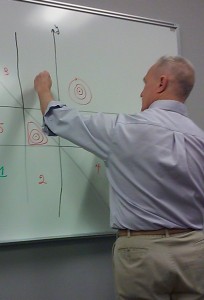Robert Bryant, Duke University
29 January 2015

Dr. Bryant began with the observation that the map is five-periodic; that is,
is the identity, at least on its domain of definition. This domain is the complement of five lines, and the map
can be easily described by how it permutes the twelve regions those five lines cut the plane into.
This is really the statement that the recurrence relation is five-periodic for any choice of initial data. Also, observe that if we set
, we get the recurrence
, which implies in turn that
. That is, any adjacent pair of the
give the same area form on the domain of the
. We call such a sequence of functions an equiareal sequence.
It turns out that periodic equiareal sequences are hard to come by. The example coming from that we just discussed is, in fact, the only such five-periodic sequence. There aren’t any four-periodic sequences, and again only one three-periodic sequence.
Examples of five-, six-, and eight-periodic sequences can be constructed from the cluster algebras respectively. Are there others? What algebra do they reflect? What can this tell us about the geometry of the surfaces whose area forms are given by the
?
Note: Dr. Bryant is an NCSU alum!